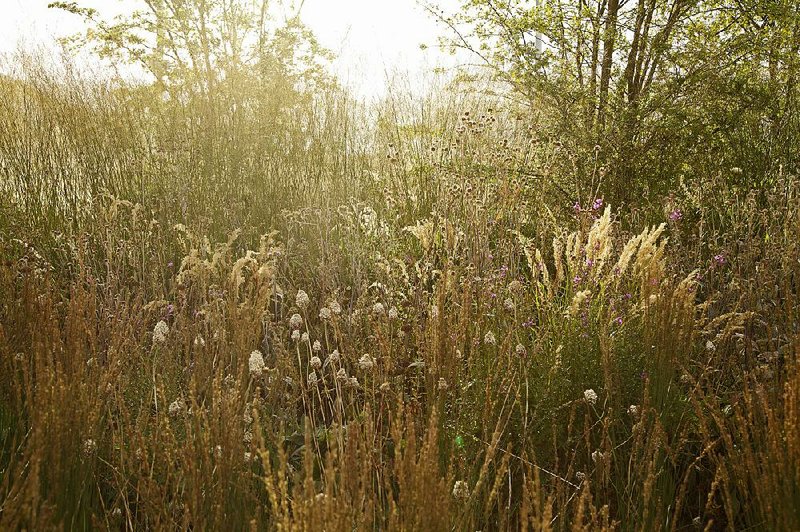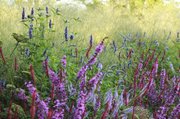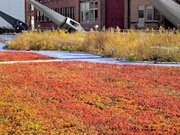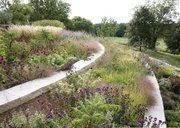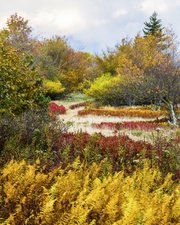Many folks, not to mention homeowners associations, cling to that model of the American yard as one of clipped foundation shrubs, groomed lawns and trees with mulch circles. Naked soil must be blanketed spring and fall with shredded mulch. Fallen leaves are treated as trash.
The real gardening world left this fusty model years ago, embracing soft groupings of perennials, grasses and specimen trees and shrubs in a celebration of plants and a closer communion with nature.
Gardening tip
Don’t bag all those leaves: They make perfect leaf mulch for conditioning garden beds. Shred leaves with a mower, rake them into a mound and collect them in a 5-gallon bucket to carry to beds for spreading. A 1- to 2-inch layer will break down over the winter, with the help of earthworms.
Thomas Rainer and Claudia West are two young plant designers -- he's 39, she's 32 -- who cut their teeth on this aesthetic and are among a new wave of influential practitioners who are pushing this naturalism to the next level.
They reject the popular approach of using indigenous plants exclusively to redeem a wilderness because such a place no longer exists: We've spent four centuries on this continent erasing it. Instead, we can bring a natural idiom to all the green places that we live with. Because more than 80 percent of the U.S. population lives in urban areas, that means rooftops, city gardens, old suburban yards, parking lots, utility easements, highway medians and the rest.
If we accept that nature as we imagined it resides in the past, they argue, we are free to turn all these immediate spaces, including our gardens, into naturalistic landscapes that will be more satisfying and less work than the lawn and manicured-shrubbery approach.
This premise is not entirely new: A generation ago, top designers were espousing "the New American Garden" with many of the same principles, of replacing lawns and shrubbery with perennials and ornamental grasses.
What has changed at the vanguard of garden design? Many more varieties of perennials are widely available now than in the 1990s and, moreover, the approach to planting design is changing fundamentally.
Rainer, West and others are promoting a shift from clumping and grouping plant varieties to mixing them in a way that occurs in nature. Discrete clumps are replaced with inter-planted varieties equipped by nature to live cheek by jowl.
"The key is to pay attention to how plants fit together," Rainer said. "To pay attention to their shape and behavior." This involves not only their growth patterns above ground, but their root types, which permit plants that are surface-rooted, such as many ground covers, to co-exist with
deep-rooted meadow flowers and grasses.
Such landscapes can look unexpectedly decorative in fall and winter, as the grasses become burnished by the cold and the remnant stalks and seed heads of perennials capture frost and snow.
Significantly, the designers reject the broadly held notion that naturalistic planting has to be of native plants, arguing that a plant's performance and adaptability are more important than its lineage. "The question is not what grew there in the past but what will grow there in the future," Rainer and West write in their new book, Planting in a Post-Wild World. Aimed at design professionals -- though of appeal to anyone who loves the process of gardening -- the book is a design manual and a manifesto.
They see the garden as no longer a collection of plants but rather a designed plant community. This is distilled into three layers. In a sunny, meadowlike garden, the uppermost layer takes the form of beefier structural perennials such as Joe-Pye weed, cup plant or Indian grass. The middle layer is the showiest and provides seasonal peaks with such things as daisies, daylilies, butterfly weeds or bee balms.
Ground covers
The most important layer, the ground cover, is the least showy. Forget tired spreads of English ivy or pachysandra; Rainer and West are thinking of sedges, small grasses, rushes. In shade gardens, the floor layer would consist of such woodland beauties as foamflower, trilliums, gingers and Allegheny spurge.
"The approach to ground cover is, for us, the single most important concept of creating a functioning plant community," they write. "Think about seeing plants in the wild; there is almost never bare soil."
The ground cover not only knits together the whole plant community physically and emotionally, but also performs an important horticultural function. Soil left bare will invite weeds, so we smother it in mulch, which has its value, but we keep piling it on for aesthetic rather than horticultural reasons. This is inherently unsustainable and expensive, and keeps lonely plantings in a perpetual state of establishment.
Rainer, who lives in Arlington, Va., is a landscape architect at Rhodeside & Harwell in Alexandria, Va. West is a horticulturist and designer with North Creek Nurseries in Landenberg, Pa. Both are popular speakers at symposiums and conventions across the country, where they reach leading landscape designers and horticulturists receptive to this ecological approach.
"It's going to be the future of landscape design," said W. Gary Smith, a Toronto- and New York-based landscape architect and a member of the American Society of Landscape Architects' education advisory committee. "What these guys are doing is showing how to plant landscapes from the soil up. It's not just about plant combinations, textures, colors; it's about looking at plant communities in the wild as an inspiration for design. It's a hybrid of horticulture and ecology, and it's been a long time coming."
Not for everyone
"It's a great concept to be presenting, and hopefully landscape architects and designers will move forward with this," said Adam Woodruff, a garden designer from Clayton, Mo., who has embraced this approach with elan. "It's not a style for everyone and it's not something everyone can do; you have to have an understanding of the plants you're working with for it to be effective."
This form of gardening is very exciting, promising to introduce many more underused plants into our gardens and, moreover, to create herbaceously dominant landscapes that are dynamic, ecologically kind and most of all, profoundly beautiful when executed with skill. The potential for it to go wrong is pretty great, though, especially if it is done on a half-baked basis. It takes fortitude and a large budget to plant perennials and ground covers by the hundreds, and I can envision stabs at this that are too timid.
One hopes that retail nurseries will make inexpensive plug plants available to consumers who are willing to maintain a young garden and wait for it to fill in.
The concept faces other obstacles. How do you get people who aren't gardeners to understand that an assembly of hairy plants is not a weed patch? Rainer told me that it is incumbent on designers to create gardens that can be read as such -- by adding more floriferous varieties to the mix, by selecting lower-growing varieties and by setting these plant communities in strong architectural frames with clear edges. "It puts the burden on designers to design in a way that it doesn't look wild," he said. "The best design interprets nature; it doesn't imitate it."
Low maintenance
What about landscape crews programmed to mow, blow, chop back dead top growth and apply pesticides and fertilizers on a schedule rather than nurture a naturalistic design through its establishment stages and through four seasons? "I feel strongly that these mixes can be much lower maintenance," he said. In the book, he and West talk about a move away from landscape maintenance to a lower pitch of management.
"This is a system based on knowledge rather than labor, and that's self-limiting in its own way," he said. "But we feel there is a paradigm shift in how plants are read, and as that knowledge catches up, there can be great benefits to landscape crews and home gardeners alike."
But perhaps I'm getting mired in the weeds. Not every car on the road today is a sleek, technologically advanced Tesla, but in 20 years it is likely that many more autos will look and work like one.
Smith said such high-profile gardens as the High Line in New York and the Lurie Garden in Chicago are teaching millions about this approach, albeit passively.
And designers such as Smith and Woodruff are finding clients who fully embrace this approach to landscape design. "I don't think I would have found that type of client 10 years ago," Smith said.
"The time is right for this kind of approach," he said. "People are really beginning to understand this aesthetic."
HomeStyle on 01/16/2016
